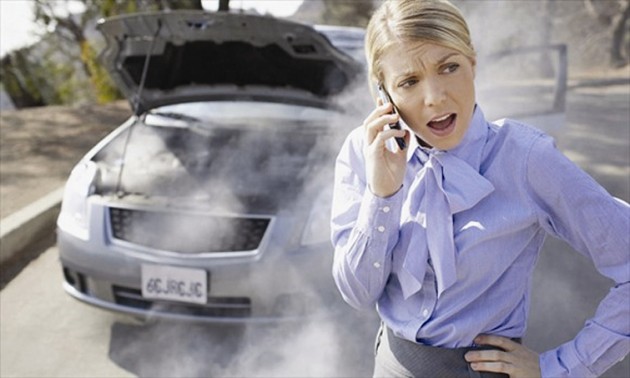
The added heat of summer driving places a strain on your car’s cooling and electrical systems. Batteries don’t live as long in high underhood temps, and the extra heat and pressure places a strain on hoses and belts. High speeds and hot pavement are also tough on tires and brakes. These are all good reasons to give your vehicle a good checkup before leaving on that vacation road trip, starting with checking the tire pressures and all the fluids. But are there good ways to prevent overheating (not you — the car)? Do you really need antifreeze in your radiator all summer? Should you use heavier oil? There are plenty of old wives’ tales, advice from distant relatives and just plain weird stuff you read on the Internet that confuses drivers. Here are some real facts about summertime and your car.
1. Does turning the heat on really help cool an engine?
Yes. The excess heat goes into the heater core, which is just a tiny radiator, pulling the temperature of the coolant down. Of course, it will rapidly overheat the interior of the car — and you. If doing this means getting to the top of that hill without boiling over, it might get you to someplace that can check the cooling system for problems. If you need to use the heater frequently to reduce coolant temperatures, either there’s something wrong with your cooling system, or you’ve seriously overloaded your vehicle.
2. Does the summertime require thicker oil?
According to the car manufacturers, yes — but don’t go too thick. Most new cars today are supposed to be filled with 5W-20, which is pretty thin. Car manufacturers usually list 10W-30 as acceptable for summer temperatures. Thinner oil has less friction inside the engine, which is good for fuel economy. Engines have been designed to run on this thin stuff for a number of years, with improved surface finish and low-friction parts like roller camshafts.
Check your owner’s manual for the viscosity recommendations for your vehicle. Older cars may require thicker oil, but it’s still not a good idea to just pour five quarts of 40-weight in just because it’s summer. Thicker oil takes longer to start flowing properly when the engine isn’t warmed up, and can also reduce fuel economy. If you live in Phoenix and tow a huge trailer, the temptation is to use thicker oil to keep it from thinning out excessively and damaging your engine. Unless you’ve got an older car, made in the era of 20W-40 or even straight grades, don’t just change your oil’s viscosity up arbitrarily. Either switch to a synthetic, or install an aftermarket oil cooler, or both.
3. What kind of coolant or mix of coolant is appropriate for summer?
Your Uncle Chuck says it’s better to use just plain water during the summer. If that’s what he’s doing, he’s running his car without any anticorrosion or antiwear additives in the cooling system, and he’ll have problems. Anytime, winter or summer, always use a 50-50 mix of fresh coolant and water. That’s true regardless of the brand or type of coolant your car manufacturer recommends. Read the label — some coolant on store shelves is already pre-diluted to 50-50.
4. Is it better to buy gasoline in the morning when the fuel is cooler? Later in the day, as the gas warms up and expands don’t you get less gas for your money?
Wrong. The daily temperature shift in underground fuel tanks is negligible, because they’re underground where the soil stays the same temp all the time.
5. Does it really use less fuel to drive with the air conditioning on than to drive with the windows open?
There’s a grain of truth in this. Opening the windows at freeway speeds increases the aerodynamic drag measurably. On the other hand, the air conditioning system consumes several horsepower. Our take: You can’t really change the aerodynamics of a huge SUV or pickup much, so if it’s not terribly warm, you probably are better off with the windows open. A Prius or some other low-drag-coefficient car will suffer more proportionally, so you might be better off with the a/c running on the highway. If you must use the a/c, open the windows and use the fan to sweep away most of the hot air before you thumb the a/c switch. The recirculate setting is the most efficient way to keep hot air out and cool air in, at least once the cabin cools off.
6. Can you save a few bucks by using older tires with less tread during the summer, when snow tires are unnecessary?
The less tread on a tire, the more poorly it will perform on a wet road. If you’re willing to stay home on rainy days, or simply park your car by the side of the road until it dries off, you’ll be fine. Otherwise, it’s time to start thinking about new tires at 4/32″ tread, and they’re an absolute necessity at 2/32″, which is when the wear bars start to show. 4/32″ is an absolute minimum tread depth for inclement weather.
7. Is it a bad idea to hide from a storm in a car because the metal frame will attract lightning?
Not really. At least not unless your car is the tallest object in the area. The car’s metal bodywork should act as a Faraday cage, safely conducting the lightning to the ground around you — that is if you’re not touching anything inside the car. (Corvette owners may fare differently). Also, it should be safe to use your cellphone inside the car — as long as it’s not connected to anything conductive, like a car charger. Pulling up to a pay phone (remember pay phones?) during an electrical storm might not be a good idea. The lightning bolt’s megavoltage could strike a nearby telephone pole, run down the wiring and wind up going straight into your ear. Ouch. What’s that funny smell?






